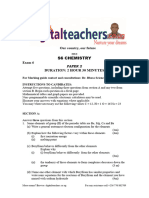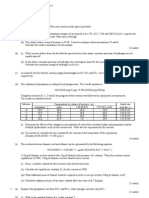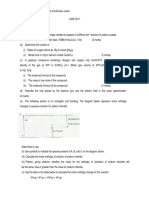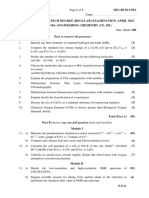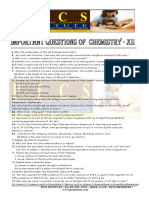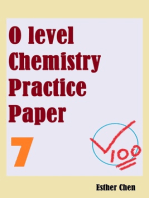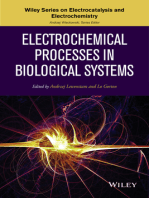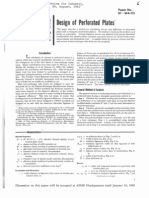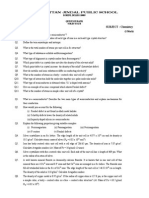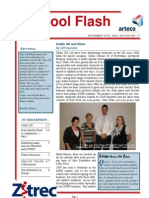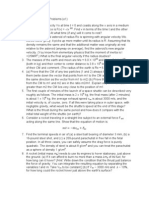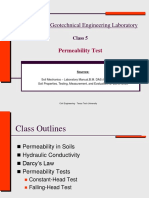Chemisty
Chemisty
Uploaded by
jembemojaCopyright:
Available Formats
Chemisty
Chemisty
Uploaded by
jembemojaOriginal Title
Copyright
Available Formats
Share this document
Did you find this document useful?
Is this content inappropriate?
Copyright:
Available Formats
Chemisty
Chemisty
Uploaded by
jembemojaCopyright:
Available Formats
DODOMA CENTRAL FITNESS PAPER CHEMISTRY PAPER 1: SERIES No.
Time: 2:30 The following constant may be use (i) (ii) (iii)
(iv)
Speed of light = 3x10 msec 1 a.m.u =K.0X10 Kg Plancks constant =6.63 x10 J Sec
R = 8.31 Jmol K or 0.0821dm atm Mol K Plancks constant =6.63 x10 J Sec R = 8.31 Jmol K or 0.0821dm atm Mol K
(v) (vi) (vii)
1. (a) Define the following term (i)Quantum numbers (ii) Hybridization (iii) (b)Complete the following chart
2(a) Explain what convergence limit and what is its significance (b)(i)An electrons which is in n=5 is supplied with energy equivalent to 1.72 x 10 J .Calculate kinetic energy of electron when ejected. (c)Consider an atom with energy level diagram shown in the figure below
An electron (e) is located at E state what will happen when an atom is incident to the following energy (i)Less than E E (ii)Equal to E E (iii)Less than E E but greater than E E (iv)Equal to E E (v) Greater than E -E 3. (a)State the Law of mass action. (b)Distinguish between equilibrium constant and reaction quotient. (c)Ammonium hydrogen sulphide ( ) solid was introduced in a 1litre bulb at 18 C and 1 atmospheric pressure. The bulb then heated to 127 C. When ammonium hydrogen sulphides dissociate and establish this equilibrium At equilibrium the total pressure was measured to be 2.16atm calculate equilibrium constant for this reaction. (a) State 4 (a) (i) A homogeneous catalyst (ii) heterogeneous catalyst (iii)Autocatalyst (b)(i)Consider the following reversible reaction 2so + o 2so H -180KJMol
Is the production of so is fevered at high temperature or low temperature (c)(i) Distinguish between activation energy and activation complex (ii)State VANT HOFFS LAW OF MOBILE 5.(a)Using the kinetic theory of gas equation PV= MCN deduce (i)The gas law equation PV=nRT (ii)Charles law equation (b)The van der Waals equation ( P+a/v )(V-b)=RT where a and b are constants is used to describe the behavior of real gas. What is significance of the term a/v and b in this equation? (c)Calculate molecular mass of a gas which has a density of 2.615g/dm at 289K and 101 Nm 6.(a)State PARTITION law (b)500 of 1.5M of ammonia solution were shacked with 50cm of chloroform in separated funnel. After allowing the layer to settle 20cm of chloroform layer were withdraw and titrated with M/20 Hydrochrolic acid 22.9cm of the acid were required for neutralization .Find the partion coefficient of ammonia between water and chloroform at the temperature of experiment.
SECTION:B Answer only three questions from this section 7. (a)(i)State the modern periodic law (ii)What are the two factors which enhance arrangement of elements in the periodic table according to increase atomic number (b) Define the following term (i)Electro negativity (ii) polarizing power (iii) Isoelectric series (iii)
(c)Why does barium nitrate impact apple green colouration to the Bunsen flame while magnesium nitrate does not when heated in open flame although both are the salt of group two elements of periodic table? 8. (a)Discuss the position of hydrogen in the periodic table (b)Explain why first member of each group show properties which are not similar to other group member. ( c) Explain the following chemical phenomena using equation if possible (i) (ii) (iii) (iv) aluminum chloride is good Lewis acid concentrated nitric acid render s aluminum passive The relative molecular weight of aluminum chloride in the vapor state is twice than expected value The NH Cl solution is acid
9 (a) what is difference between hydration and hydrolysis? (b)Give two supportive reaction equation to show Cleary the contrast between hydrolysis and hydration (b)(i)Explain why extraction of aluminum does not required aqueous material (ii)Iodine and chlorine are both found in the same group of the periodic table but hydrogen iodide is strong reducing agent than hydrogen chloride (c)Aluminum and beryllium are diagonally related in the periodic table .By considering this element s explain why element which are related diagonally have similar properties .Give at least five diagonal properties between aluminum and beryllium.
10(a) Explain in term of their electronic configuration why Fe ions are ready oxidized to Fe ion but Mn ion are not ready oxidized to Mn ions (b)Explain the following chemical phenomena using equation where possible (i) Beryllium oxide is amphoteric (ii)Nitrogen hydride has high exceptionally high boiling point compared to the the hydride of its group member (c)Explain what is screening effect..? and can screening effect used to determine reactivity SECTION:C Answer three (3 )questions from this section 11. (a)Name the following compound using IUPAC system of nomenclature (i) CH C Br (ii) OH
(ii)CH C C CH OH (iii) CH C CH CH C CH
(iv )CH C O CH
(iii) 4.1g of bromoalkane was reacted with excess sodium hydroxide solution. The resulting solution was acidified with excess nitric acid and dilute to exactly 250cm .25cm of this solution required 33.28cm of 0.1M of AgNO solution for complete precipitate of silver bromide (i)Calculate a relative molecul ar mass of a bromoalkane (ii)From your answer in (i) above deduce molecular formulae of a bromoalkane (iii)Write possible isomers
12.(a) Indicate how the following mixture could be separated without distillation (i)Butyne and But-2-yne (ii) Butene and butane
(b)Give equations that illustrate good method to synthesis each of the following C H CH +F CO C H (i)2-bromobutane from 1-bromobutane ii)1-bromobutane from 2-bromobutane (iii)CH CH CH CH CH CH from CH CH CH CHOH 13. Consider the reactions below (i) (ii) (iii) (iv) (v) (vi) C H CH +F CH CO C H CH (i) A+O +Zn+H O (C H O)+(C H O) (ii)B D (iii) 2B +Cold NaOH E(C H O ) (iv ) D+SOCl F+HCl +SO (vi)CH C C H CH +Conc HCl G
CH
(a)Name type of reactions from (i) to (vi) (b)Write the symmetric IUPAC names and structure of compound A,B,C,D,E,F and G 14 0.037g of alcohol was added to CH mgI and gas involved measured 11.2cm at STP what is molecular mass of alcohol Suppose the alcohol is primary alcohol and non branched .Show how you will convert that alcohol to (i)Ethanal only (ii)Propanone (ii)Ethane
Prepared by FRANK CYPRIAN SARARA 0717248208 24/09/2011
You might also like
- NSS Chemistry Part 2 Microscopic World I - LQDocument22 pagesNSS Chemistry Part 2 Microscopic World I - LQFelix YueNo ratings yet
- STPM Trials 2009 Chemistry Paper 2 (SMJK Sam Tet Ipoh)Document11 pagesSTPM Trials 2009 Chemistry Paper 2 (SMJK Sam Tet Ipoh)sherry_christyNo ratings yet
- A Level Chemistry Paper 2 Exam 6Document4 pagesA Level Chemistry Paper 2 Exam 6majanga johnNo ratings yet
- PA -IV Qp_12 Chemistry (1)Document5 pagesPA -IV Qp_12 Chemistry (1)krishnaghodke03No ratings yet
- TCN Seminar Final 2023Document16 pagesTCN Seminar Final 2023azabenjamin2007No ratings yet
- SET PAPER 5 - CHEM Eklavya (XII-CBSE) 01.02.2024 FULL (WM)Document5 pagesSET PAPER 5 - CHEM Eklavya (XII-CBSE) 01.02.2024 FULL (WM)Rahul YadavNo ratings yet
- ALEVELREVISIONQUESTIONSDocument7 pagesALEVELREVISIONQUESTIONSAnthony AndyNo ratings yet
- s6 Chem ExamDocument10 pagess6 Chem Examscoin502No ratings yet
- AL Chemistry 1995-1998 Paper 1Document18 pagesAL Chemistry 1995-1998 Paper 1api-3734333No ratings yet
- Chemistry Practice Question Paper Class 12Document7 pagesChemistry Practice Question Paper Class 12tony starkNo ratings yet
- 12thchemistrysamplepaper1 291223044313Document9 pages12thchemistrysamplepaper1 291223044313aditikharb2020No ratings yet
- Chemistry 1 - ExamDocument6 pagesChemistry 1 - Examnassorussi9No ratings yet
- XII CHEMISTRY Pre Board 2 - 2023Document6 pagesXII CHEMISTRY Pre Board 2 - 2023VOLTZNo ratings yet
- Chem 1Document5 pagesChem 1kakajumaNo ratings yet
- Form Six Chemistry 1Document6 pagesForm Six Chemistry 1abubakarimuyanaNo ratings yet
- Practice Paper-II Subject: Chemistry (Theory) Class: XI Time: 3 Hrs. M.M.: 70Document5 pagesPractice Paper-II Subject: Chemistry (Theory) Class: XI Time: 3 Hrs. M.M.: 70Uddipta K. SaikiaNo ratings yet
- Chem QP 9Document5 pagesChem QP 9jagpreetNo ratings yet
- Chem Cgce 2011 A/lDocument9 pagesChem Cgce 2011 A/lmengotNo ratings yet
- Chemical Sciences - Paper I (Part B) (WWW - Entrance-Exam - Net) .Document13 pagesChemical Sciences - Paper I (Part B) (WWW - Entrance-Exam - Net) .OmSilence2651No ratings yet
- Chem QP 1Document7 pagesChem QP 1coolgameryt89No ratings yet
- JJKDocument11 pagesJJKAnonymous pa8pSCC15No ratings yet
- 220Document7 pages220ragavijayaraman2926No ratings yet
- SET-1-M QP Chemistry BoardDocument7 pagesSET-1-M QP Chemistry Boardtejaswia2007No ratings yet
- Chemistry 2 - Exam n Answers - Msomibora.com(3)Document15 pagesChemistry 2 - Exam n Answers - Msomibora.com(3)ngashuheNo ratings yet
- Chemistry Paper MathsDocument5 pagesChemistry Paper Mathszy6136No ratings yet
- Perboard 2023-24Document9 pagesPerboard 2023-24All Rounder creative TechniquesNo ratings yet
- Xii Chem Papaer KV ChameraDocument4 pagesXii Chem Papaer KV ChamerarahulNo ratings yet
- Chemistry SQP PDFDocument8 pagesChemistry SQP PDFÀĺťhàf AnsariNo ratings yet
- Code:SP/LV-2 Sample Paper: General InstructionsDocument3 pagesCode:SP/LV-2 Sample Paper: General InstructionsKhogen MairembamNo ratings yet
- A Level QnsDocument18 pagesA Level QnsowenmuthendeNo ratings yet
- A Level Chemistry 2 Mocks UMTADocument7 pagesA Level Chemistry 2 Mocks UMTAmakueimadol17No ratings yet
- S6 Chemistry TestDocument16 pagesS6 Chemistry TestYassin MuragijimanaNo ratings yet
- assignment class 12 physics by bhupendra sirDocument7 pagesassignment class 12 physics by bhupendra sirmeenabisht16185No ratings yet
- Chemistry PreboardDocument23 pagesChemistry PreboardSimma RaoNo ratings yet
- Cy0u10a R Engineering Chemistry Apr 2022Document3 pagesCy0u10a R Engineering Chemistry Apr 2022kangirene9705No ratings yet
- JUNE 2013 Section A: Physical and General Chemistry (Answer Only TWO Questions in This Section)Document10 pagesJUNE 2013 Section A: Physical and General Chemistry (Answer Only TWO Questions in This Section)Zozo FozaoNo ratings yet
- Important Question For ThemDocument3 pagesImportant Question For Themvinay saxenaNo ratings yet
- Chemistry SQP XII PDFDocument14 pagesChemistry SQP XII PDFIshikaGuptaNo ratings yet
- Unit Test Sample Paper Grade 12 ChemistryDocument6 pagesUnit Test Sample Paper Grade 12 Chemistrymilonee lNo ratings yet
- Chemistry s4 Theory and Pract.Document26 pagesChemistry s4 Theory and Pract.kubwimanajeandamour359No ratings yet
- Preboards 2 PAPER EXAMINATION 2023 - 24 CLASS 12 CHEMDocument7 pagesPreboards 2 PAPER EXAMINATION 2023 - 24 CLASS 12 CHEManuskakittudasNo ratings yet
- Chemistry 1Document5 pagesChemistry 1youngtillionez99No ratings yet
- Annual Exam - Class 11 - Chemistry Question PaperDocument4 pagesAnnual Exam - Class 11 - Chemistry Question PaperADITIYA50% (2)
- G12 October examDocument4 pagesG12 October examNay Myo Lin (Kouji)No ratings yet
- Guess Paper First Year Chemistry by Pakistan College of Science and Commerce Multan 2024Document4 pagesGuess Paper First Year Chemistry by Pakistan College of Science and Commerce Multan 2024حورم فاطمہNo ratings yet
- LPS mock paper 8 chaptersDocument8 pagesLPS mock paper 8 chaptersishvaryaNo ratings yet
- XIIChemistry_PB3_F_241212_184905 (1)_241212_224828Document4 pagesXIIChemistry_PB3_F_241212_184905 (1)_241212_224828irajsinghvardhanNo ratings yet
- AL Chemistry 1996 Paper 1+2Document12 pagesAL Chemistry 1996 Paper 1+2api-3734333No ratings yet
- 1996 2009 Kcse Chemistry 1Document177 pages1996 2009 Kcse Chemistry 1W GNo ratings yet
- Ok A'level Chem Seminar 2024Document18 pagesOk A'level Chem Seminar 2024stephenokwera424No ratings yet
- ChemistryDocument32 pagesChemistry190519123No ratings yet
- The Pinewood International Senior Secondary School Class - 11Document2 pagesThe Pinewood International Senior Secondary School Class - 11k6n6mgmrmnNo ratings yet
- Chem Hy XiiDocument6 pagesChem Hy XiinavaneethemadriNo ratings yet
- SXHS XII (CHEM) P.T-2 Imp Questions 2023Document7 pagesSXHS XII (CHEM) P.T-2 Imp Questions 2023sampritmodiNo ratings yet
- CBSE Sample Paper 2020.pdf202110050830371633422637Document13 pagesCBSE Sample Paper 2020.pdf202110050830371633422637aashishkm321No ratings yet
- Practise Paper Xi Set I-ChemDocument7 pagesPractise Paper Xi Set I-ChemsonukatochjmiNo ratings yet
- Electrochemical Processes in Biological SystemsFrom EverandElectrochemical Processes in Biological SystemsAndrzej LewenstamNo ratings yet
- 148 Sample ChapterDocument19 pages148 Sample ChapterSyafanaNo ratings yet
- Design of Perforated PlatesDocument13 pagesDesign of Perforated PlatesScribdUserBest100% (1)
- 9702 w11 Ms 22Document4 pages9702 w11 Ms 22Hubbak KhanNo ratings yet
- 18 Quantitative Aspects of Chemical ChangeDocument30 pages18 Quantitative Aspects of Chemical Changeapi-235269401No ratings yet
- Introduction To Nano MaterialsDocument25 pagesIntroduction To Nano Materialsadam AlhusseniNo ratings yet
- Class Xii Chemistry Question Banks Solid StateDocument2 pagesClass Xii Chemistry Question Banks Solid StateKrishan GuptaNo ratings yet
- 0910 Cool Flash - Edition 17-1Document8 pages0910 Cool Flash - Edition 17-1miguel_marshNo ratings yet
- Suggested Problems E1Document2 pagesSuggested Problems E1rezakabaNo ratings yet
- Lab RepDocument4 pagesLab RepGil NIsmalNo ratings yet
- Gauss's Law For Magnetism - Wikipedia, The Free EncyclopediaDocument4 pagesGauss's Law For Magnetism - Wikipedia, The Free Encyclopediabeta2009No ratings yet
- Relativity - HomeworkDocument15 pagesRelativity - HomeworkRacoNo ratings yet
- Metal Reactivity Ws2016ansDocument3 pagesMetal Reactivity Ws2016ansHemant Kumar50% (2)
- Expirement No 1Document4 pagesExpirement No 1Rajiv KharbandaNo ratings yet
- Prog 26 Introduction To Laplace TransformsDocument29 pagesProg 26 Introduction To Laplace TransformsZazliana IzattiNo ratings yet
- Permeability Test Laboratory PDFDocument18 pagesPermeability Test Laboratory PDFFilipe MartinsNo ratings yet
- Atkins P 787-788Document2 pagesAtkins P 787-788charls00No ratings yet
- SedimentationDocument39 pagesSedimentationConrad MonterolaNo ratings yet
- Physics II Problems PDFDocument1 pagePhysics II Problems PDFBOSS BOSSNo ratings yet
- Cytec Solutions 2012Document40 pagesCytec Solutions 2012Jersson Daniel Davila RuizNo ratings yet
- Black Body RadiationDocument16 pagesBlack Body RadiationIRFANSYAH ANAK SIRAITNo ratings yet
- 6 FM CircuitsDocument33 pages6 FM CircuitsHitech Devices100% (1)
- Refresher QuestionsDocument33 pagesRefresher QuestionsJoel James Gomez EvangelioNo ratings yet
- Report of Inspection, Testing & Maintenance of Fire Pump AssembliesDocument6 pagesReport of Inspection, Testing & Maintenance of Fire Pump Assembliessl1828100% (2)
- Civil Engg 2005 PDFDocument28 pagesCivil Engg 2005 PDFSowjanyaReddyNo ratings yet
- Radiation Properties of Surfaces: N Specular Direction I R Reflected RaysDocument21 pagesRadiation Properties of Surfaces: N Specular Direction I R Reflected RayscaptainhassNo ratings yet
- Exercises August 14, 2019Document3 pagesExercises August 14, 2019Lester Patalinghug BernardinoNo ratings yet
- EP Assignment Spring 2015 PDFDocument6 pagesEP Assignment Spring 2015 PDFanon_429934438No ratings yet
- What's Common For Beer Mug and Power Factor - EEPDocument4 pagesWhat's Common For Beer Mug and Power Factor - EEPcatalinccNo ratings yet
- Motors PDFDocument6 pagesMotors PDFMark Anthony Sabio LuceroNo ratings yet
- The Solid StateDocument8 pagesThe Solid StateAnonymous 8VJhV1eI2yNo ratings yet


